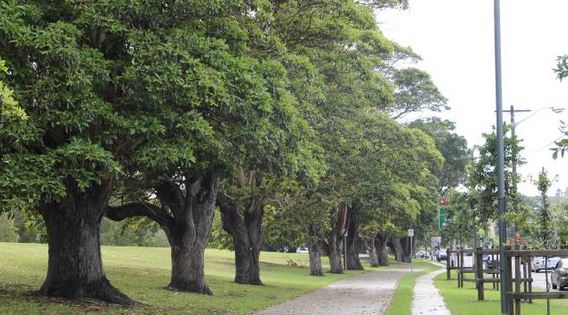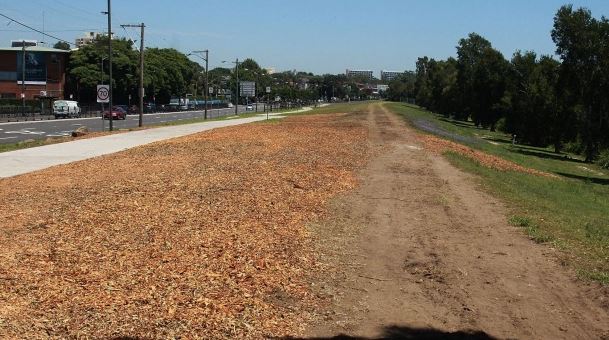
The Elevation of Urban Ugliness
 In just a few recent days, a line of historic and beautiful fig trees along Sydney’s Anzac Parade fell. No storm was involved. No act of God. This was man’s mechanical doing. And it all happened with the full, prior, knowledge and approval of NSW’s Baird government, which is building a new light-rail corridor from the city to Randwick and Kingsford. Future racegoers will roll to the track and students glide to the nearby University of NSW. But none of us will ever again enjoy the wonderful sylvan vista of mighty figs along Moore Park.
In just a few recent days, a line of historic and beautiful fig trees along Sydney’s Anzac Parade fell. No storm was involved. No act of God. This was man’s mechanical doing. And it all happened with the full, prior, knowledge and approval of NSW’s Baird government, which is building a new light-rail corridor from the city to Randwick and Kingsford. Future racegoers will roll to the track and students glide to the nearby University of NSW. But none of us will ever again enjoy the wonderful sylvan vista of mighty figs along Moore Park.
As Ogden Nash could have writ, I think I shall never see a light rail lovely as a tree. But then, the masters of light rail promise that so many more trees are to be planted instead. Nonetheless, I regret that the lovely, symmetric, shade-filled avenue that was Anzac Parade is now gone forever, the latest casualties of a philosophy and aesthetic that values ugly, multi-lane roads, steel forests of signage, and endless strips of tacky shops festooned with eyesore ads. Cheapskate developers, tasteless architects, and uncaring town planners conspire to see the urban jungle grow ever more distasteful to the eye.
And we do nothing about it.
Where, oh, where are all those inner city Green voters? (Admittedly, a few did chain themselves to Anzac Parade figs for a while, hugging trees on death row.) But 99% of the time, Greenies who say they care deeply about our environment seem to achieve little to preserve good urban environment.
It’s all very well to go on about the Tarkine or the Daintree or even the mighty Snowy, but these far flung corners of our country are not where average Australians spend much time, let alone reside. In the century since agriculture mechanised, and forest industries were all but shut, most Australians have ended up staring at each other — and the ugly face of urbanity — from suburban windows.
Australia’s cities urgently need work done – and not just with a mop, a bucket and a lick of paint. Most of our urban spaces need serious re-thinking, to improve their utility, safety and beauty. Inspired urban development can be wonderful: Avenues of trees, unspoiled by wires overhead. Buildings that match, amuse and appeal. A minimum of poles, signage and visual distraction. It works. We have all been places where, suddenly, it is clear we are in a pleasant, urban environment. The pulse quickens, the spirits lift, and the happiness of living visits our heart for a moment or two.
Rome wasn’t built in a day, and big, urban makeover projects take time. But instead, too often the overseers of our cities and suburbs seem to approve, or at least turn a blind eye, to yet more urban uglification. Each new blight that gets put up will one day have to come down.
Perhaps they just don’t see it. Perhaps, after years of trying to juggle society’s competing priorities — more roads, more residences, more commerce, more recreation — many planners have thrown up their hands in despair, capitulated to ugliness and accepted it as an unfortunate necessity.
Future generations will likely judge us harshly for the growing urban blight we will leave behind: Rough concrete, dirty and littered tarmac, cluttered signposts, lamp poles, high and intimidating walls and rusting steel fences, stained brickwork, poorly-executed murals or masses of crude, moronic and threatening graffiti. Surely we can do better!
Local councils are merging across Sydney this year – another grand project of the tree-felling, Baird government. Wouldn’t it be great if each new officer, alderman and mayor pledged to work towards making Sydney what it claims to be, one of the most beautiful urban environments in the world? Yes, it would take ideas, enthusiasm, and investment. But, yes, all that would be most worthwhile.
Here are a few ideas:
- Ask Sydneysiders (and visitors) which aspects of urban blight upset them most. Let them nominate the eyesores, plus suggestions for fixing them. (The power of 10,000 minds connected via the Internet can beat the power of one bored council employee at a desk.)
- Get local businesses and their customers to discuss how commercial and retail areas might transform themselves in order to delight and attract. Businesses that struggle to succeed amongst urban ugliness have much to gain from a makeover.
- Highlight where we have the urban environment right as examples to be followed. Which local shopping centres work well? Where are our most admired urban roads and vistas? What urban design has produced practical, beautiful results?
- Insist that any development, whether a second-storey on a suburban house or a new tower block of apartments, add to the visual amenity of its surroundings. No more tick-box lists for council approval, regardless of the ugly, inappropriate nature of the proposed construction.
- Tear down the ugliest examples of urban development. Not all at once, but over the course of, say, the next ten years, with incentives to make their replacements worthy of admiration. We can create a beautiful, functional, safe and economically responsible urban environment. But we need to make the effort.
Or do we hide collectively behind the lace curtains of our front window, fearing that nothing can be done, and turning on the TV yet again, to watch a documentary on the rainforest?
Madam: Archbishop Fisher (July-August 2024) does not resist the attacks on his church by the political, social or scientific atheists and those who insist on not being told what to do.
Aug 29 2024
6 mins
To claim Aborigines have the world's oldest continuous culture is to misunderstand the meaning of culture, which continuously changes over time and location. For a culture not to change over time would be a reproach and certainly not a cause for celebration, for it would indicate that there had been no capacity to adapt. Clearly this has not been the case
Aug 20 2024
23 mins
A friend and longtime supporter of Quadrant, Clive James sent us a poem in 2010, which we published in our December issue. Like the Taronga Park Aquarium he recalls in its 'mocked-up sandstone cave' it's not to be forgotten
Aug 16 2024
2 mins









